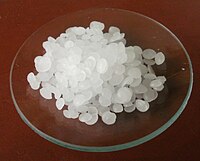
Photo from wikipedia
Abstract This work was conducted to discover ways of processing high-paraffin oil residues using thermochemical processes to obtain binders. The principal purpose of such treatment of high-paraffinic residues is in… Click to show full abstract
Abstract This work was conducted to discover ways of processing high-paraffin oil residues using thermochemical processes to obtain binders. The principal purpose of such treatment of high-paraffinic residues is in the thermocatalytic process which consists of dehydroesterification via oxidation of paraffins which increase bitumen’s low-temperature stability (Fraass breaking point). Thus the n-alkanes, via our thermocatalytic process, can form several carbonyl compounds and oxidised compounds (such as alcohols, carboxylic acids, etc.). The thermocatalytic process of petroleum’s raw materials in our research carried out in two stages, including the catalytic process, as well as the thermal oxidation by air-blowing process. In this study, we used a biturox reactor. We evaluated the content of paraffin with GOST 33139 and low-field nuclear magnetic resonance (1H LF-NMR) relaxometry in high-paraffinic vacuum residues, and after our thermocatalytic process in the obtained product. Moreover, in order to ensure the reliability of results obtained through the processing of vacuum residues as well as the obtained product, various physicochemical methods were used. These investigation methods include SARA fractionation, Fourier-transform infrared spectroscopy, electron paramagnetic resonance (EPR), and VNII NP analysis. Furthermore, the colloidal structures were studied using the Gaestel and Asphaltene Index. The tests were carried out to determine the bitumen’s quality under the Russian interstate standard GOST 33133-2014 and the European standard EN 12591.
Journal Title: Construction and Building Materials
Year Published: 2021
Link to full text (if available)
Share on Social Media: Sign Up to like & get
recommendations!